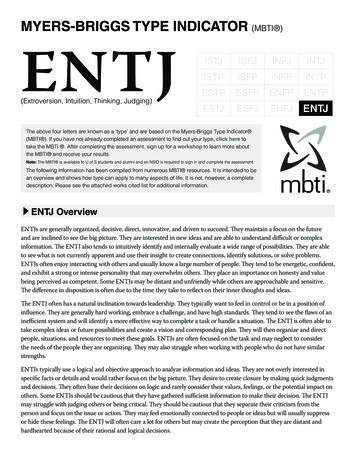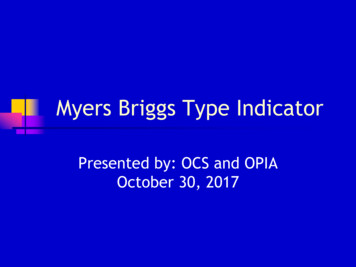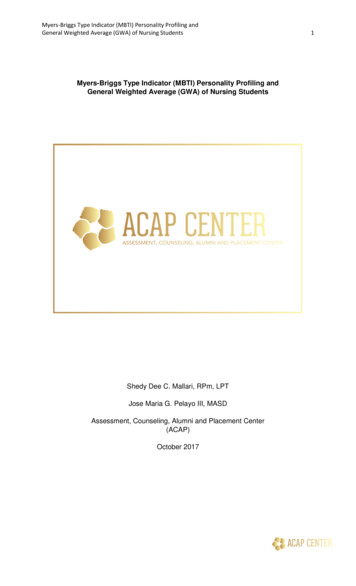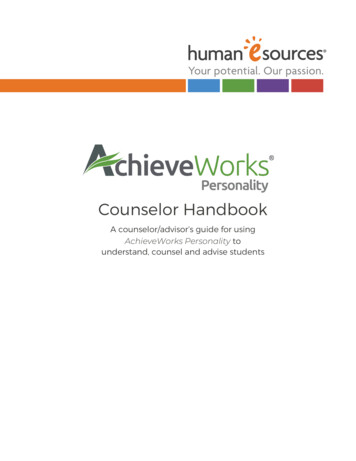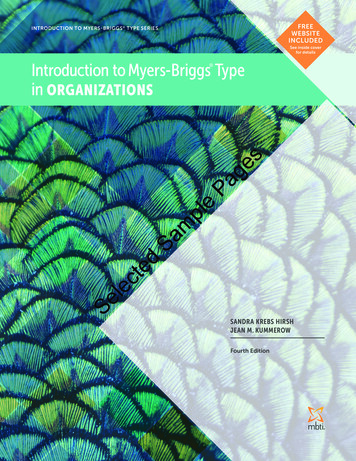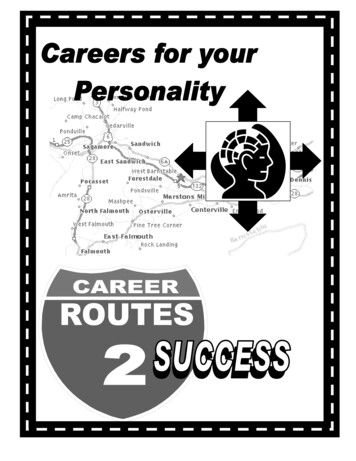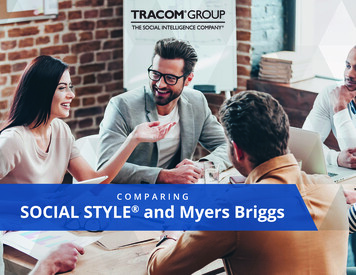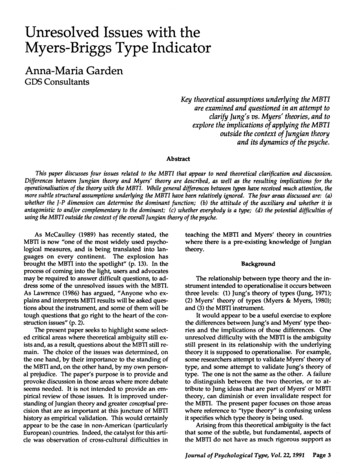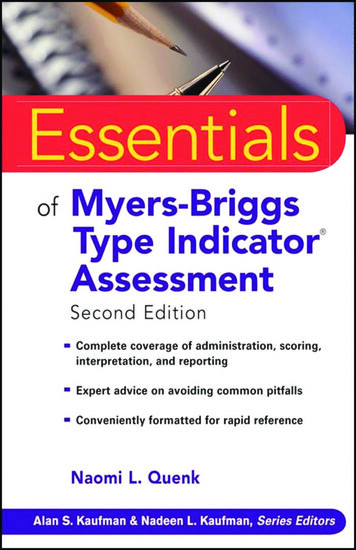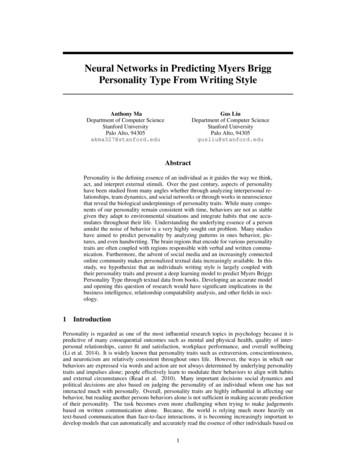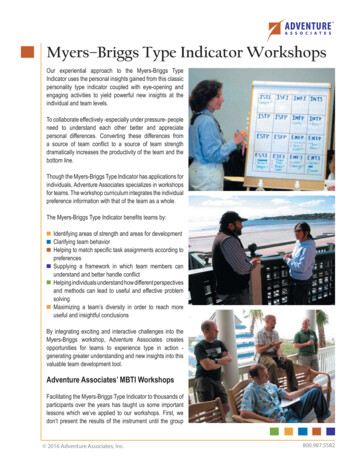
Transcription
Myers–Briggs Type Indicator WorkshopsOur experiential approach to the Myers-Briggs TypeIndicator uses the personal insights gained from this classicpersonality type indicator coupled with eye-opening andengaging activities to yield powerful new insights at theindividual and team levels.To collaborate effectively -especially under pressure- peopleneed to understand each other better and appreciatepersonal differences. Converting these differences froma source of team conflict to a source of team strengthdramatically increases the productivity of the team and thebottom line.Though the Myers-Briggs Type Indicator has applications forindividuals, Adventure Associates specializes in workshopsfor teams. The workshop curriculum integrates the individualpreference information with that of the team as a whole.The Myers-Briggs Type Indicator benefits teams by:Identifying areas of strength and areas for developmentClarifying team behaviorHelping to match specific task assignments according topreferencesSupplying a framework in which team members canunderstand and better handle conflictHelping individuals understand how different perspectivesand methods can lead to useful and effective problemsolvingMaximizing a team’s diversity in order to reach moreuseful and insightful conclusionsBy integrating exciting and interactive challenges into theMyers-Briggs workshop, Adventure Associates createsopportunities for teams to experience type in action generating greater understanding and new insights into thisvaluable team development tool.Adventure Associates’ MBTI WorkshopsFacilitating the Myers-Briggs Type Indicator to thousands ofparticipants over the years has taught us some importantlessons which we’ve applied to our workshops. First, wedon’t present the results of the instrument until the group 2016 Adventure Associates, Inc.800.987.5582
has had an opportunity to learnabout all four dichotomies andsixteen type preferences. Thisprevents participants from tuningout information “because it doesn’tpertain to him or her.” Once thegroup has the necessary context,provided through interactive problem-solving challenges, exercisesand discussion, they’re much better able to assess the type preferences of others. The end result isless bias against other type preferences and a deeper understandingof their own type preference.The other adaptation we’ve madeover the years to the benefit of ourclients is to address the Sensing/Intuition and Thinking/Feelingdichotic pairings first, and then delve into Extraversion/Introversion and Judging/Perceiving. The first two pairings focus onhow data is collected and decisions are made. The latter two pairings have the potential to be more divisive as individuals havestronger feelings about which is “preferable.”Many more conflicts in the workplace arise from misunderstandings around Extraversion/Introversion and Judging/Perceivingthan Sensing/Intuition and Thinking/Feeling. By ordering the agenda in this fashion, we create an atmosphere of readiness inyour group that makes the E/I and J/P discussions much more positive and results-oriented.Half–Day and Full–Day WorkshopsWe offer the Myers-Briggs Type Indicator in 4-hour and 7-hour workshops. During the half-day workshop, we instruct the groupabout the four dichotic pairings and the sixteen type preferences. Participants experience “personality in action” through afew interactive challenges and discussions, learn their individual type preferences, and begin to craft strategies for leveragingareas of strength and compensating for areas for development.Time allowing, we highly recommend our clients participate in the full-day workshop. Your group will not only benefit fromthe individual breakthroughs of the half-day workshop, but have much more time to address “team type” in-depth and createeven more strategies and awareness around specific workplace situations. (See Supplemental MBTI Information for specificexamples.)The culture of your team is largely influenced by the unique combination of your individual type preferences. For example, ifyou have a group of 15, and 10 of them are Extroverts, then your team type is Extroverted. This has ramifications in the waymeetings are conducted, information is shared and in how team members communicate. Even though two co-workers may sitside-by-side, their daily work experiences can be different depending on whether their preference aligns with the team type oris different than the team type. 2016 Adventure Associates, Inc.800.987.5582
SAMPLE AGENDA Half-DayIntroductionIn order to get the team more comfortable with each other and accustomed to the experiential process, we lead a fun activity.Then we briefly cover the purpose of the workshop, the instrument’s history, answer questions about the use of the MBTI andlay the groundwork for the rest of the workshop. (approximately 20 minutes)Sensing & Intuition Self-Evaluation and DiscussionOur facilitator leads your group through an interactive process in which individuals decide which of those preferences resonatesmore closely. (approximately 20 minutes)Thinking & Feeling Self-Evaluation and DiscussionYour team will evaluate their preferences around thinking and feeling through a facilitator-led activity.(approximately 20 minutes)Interactive ChallengeTypically, we employ a problem-solving activity that illuminates how information is gathered and processed. Not only doesthe challenge serve to get your group out of their seats, but it also allows them to see type in action, making it easier to drawcorrelations to the workplace dynamics. (approximately 20 minutes)Extraversion & Introversion Self-Evaluation and DiscussionFirst alone, then with a partner, participants examine their perceptions of Extraversion and Introversion, then converse withlike-types about the issues that face them in the workplace. (approximately 20 minutes)Judging & Perceiving Self-Evaluation and DiscussionThe final dichotic pairing that we cover is Judging and Perceiving. Participants find this one of the easiest to understand andapply. Upon completion of this discussion, participants will have self-selected the type preference that most closely matcheshim or her. (approximately 20 minutes)Distribute MBTI ResultsEach participant receives a report on their MBTI preference based on the online instrument completed prior to the workshop.By moving this to the end of the workshop, we encourage open exploration of the various types, prevent biases from forming(Extraverts vs. Introverts, etc.) and ensure that participants don’t filter out information “that doesn’t apply to them.” A smallpercentage of participants will select a slightly different type than what the instrument prescribes. Typically this uncovers thedifference between how we behave at work and how we behave in our private lives. (approximately 30 minutes)Team Type Table DiscussionBy combining the MBTI results of your group, we arrive at a Team Type Table. The cumulative type greatly impacts the workculture. For example, if you have a group of 15, and 12 are Extraverts, then your team culture is Extraverted. This impactseveryone on the team, but requires special consideration to be given to the 3 members who happen to be Introverted. Duringthis discussion, we address any areas for which your group may need to compensate as well as natural strengths, while yourgroup shares insights about your team’s future development. (approximately 40 minutes)Final DebriefParticipants have an opportunity to ask clarifying questions, share insights and reflect on how they might apply some of thisinformation back to the workplace. (approximately 20 minutes)Program Complete (approximately 4 hours including two 10-minute breaks) 2016 Adventure Associates, Inc.800.987.5582
SAMPLE AGENDAFull-DayIntroductionIn order to get the team morecomfortable with each other andaccustomed to the experientialprocess, we lead a fun activity. Thenwe briefly cover the purpose of theworkshop, the instrument’s history,answer questions about the use of theMBTI and lay the groundwork for therest of the workshop. (approximately20 minutes)Sensing & Intuition Self-Evaluation and DiscussionOur facilitator leads your group through an interactive process in which individuals decide which of those preferences resonatesmore closely. (approximately 25 minutes)Thinking & Feeling Self-Evaluation and DiscussionYour team will evaluate their preferences around thinking and feeling through a facilitator-led activity.(approximately 25 minutes)Interactive ChallengeTypically, we employ a problem-solving activity that illuminates how information is gathered and processed. Not only doesthe challenge serve to get your group out of their seats, but it also allows them to see type in action, making it easier to drawcorrelations to the workplace dynamics. (approximately 30 minutes)Extraversion & Introversion Self-Evaluation and DiscussionFirst alone, then with a partner, participants examine their perceptions of Extraversion and Introversion, then converse withlike-types about the issues that face them in the workplace. (approximately 25 minutes)Judging & Perceiving Self-Evaluation and DiscussionThe final dichotic pairing that we cover is Judging and Perceiving. Participants find this one of the easiest to understand andapply. Upon completion of this discussion, participants will have self-selected the type preference that most closely matcheshim or her. (approximately 25 minutes)Z-Problem Solving Model and Facilitated Team ChallengeParticipants review this model, then apply it in a challenge, Medley. This is one of the key areas of the workshop in which yourgroup will examine their current problem-solving approach and make modifications based on what they uncover about theirown and other preferences. (approximately 20 minutes)Facilitated Team ChallengeYour group will have the chance to apply the Z-Problem Solving Model in an activity like Pipeline (however, we have manyactivities from which to choose). (approximately 30 minutes)Pipeline– Teams try to move a small ball from the starting line to the finish bucket without stopping or dropping the ball. Acoordinated team effort is required to manage the assortment of pipeline components. 2016 Adventure Associates, Inc.800.987.5582
The Web– Pass through various size holes in agiant web structure without touching the string orusing any of the openings more than once. Thischallenge requires a great deal of cooperation,trust and “start to finish” planning to enable theteam to be successful.Distribute MBTI ResultsEach participant receives a report on their MBTIpreference based on the online instrumentcompleted prior to the workshop. By movingthis to the end of the workshop, we encourageopen exploration of the various types, preventbiases from forming (Extraverts vs. Introverts,etc.) and ensure that participants don’t filterout information “that doesn’t apply to them.” Asmall percentage of participants will select aslightly different type than what the instrumentprescribes. Typically this uncovers the differencebetween how we behave at work and how webehave in our private lives. (approximately 30minutes)Team Type Table DiscussionBy combining the MBTI results of your group, we arrive at a Team Type Table. The cumulative type greatly impacts the workculture. For example, if you have a group of 15, and 12 are Extraverts, then your team culture is Extraverted. This impactseveryone on the team, but requires special consideration to be given to the 3 members who happen to be Introverted. Duringthis discussion, we address any areas for which your group may need to compensate as well as natural strengths, while yourgroup shares insights about your team’s future development. (approximately 25 minutes)MBTI Behavior CuesBeing able to “guess” another person’s type is a valuable skill. It can change the way you choose to communicate with them,how much detail (or lack thereof) you include in explanations, whether you do it via email or in-person. We’ll cover some ofthe behavior cues that we can read and interpret about others, and discuss how we might change our approach with themaccordingly. This is particularly valuable when dealing with other departments or external clients who may not have beenexposed to MBTI principles. (approximately 25 minutes)Brainstorming & PlanningIt is at this stage in the workshop that your group looks at “what do we do now?” Past participants have restructured the waythey prepare for and hold meetings, run performance evaluations, developed email templates and protocols, interacted withclients (internal and external), and compiled data and reports for review. (approximately 40 minutes)Final DebriefParticipants have an opportunity to ask clarifying questions, share insights and reflect on how they might apply some of thisinformation back to the workplace. (approximately 15 minutes)Program Complete(approximately 8 hours including two 10-minute breaks and a 30-minute lunch) 2016 Adventure Associates, Inc.800.987.5582
Myers–Briggs Type Indicator Workshops Our experiential approach to the Myers-Briggs Type Indicator uses the personal insights gained from this classic personality type indicator coupled with eye-opening an

